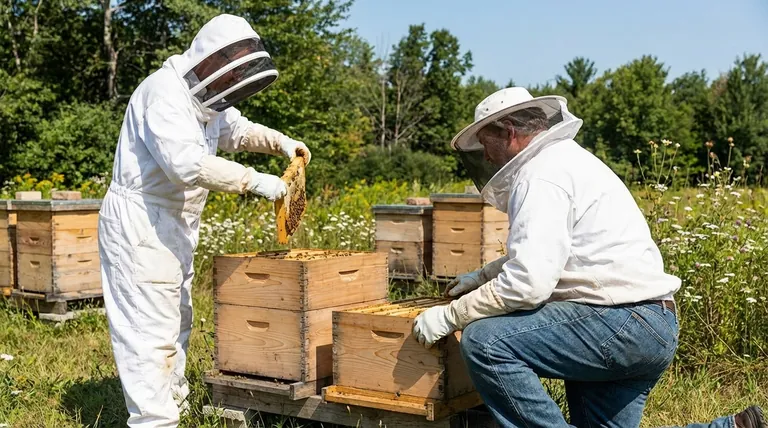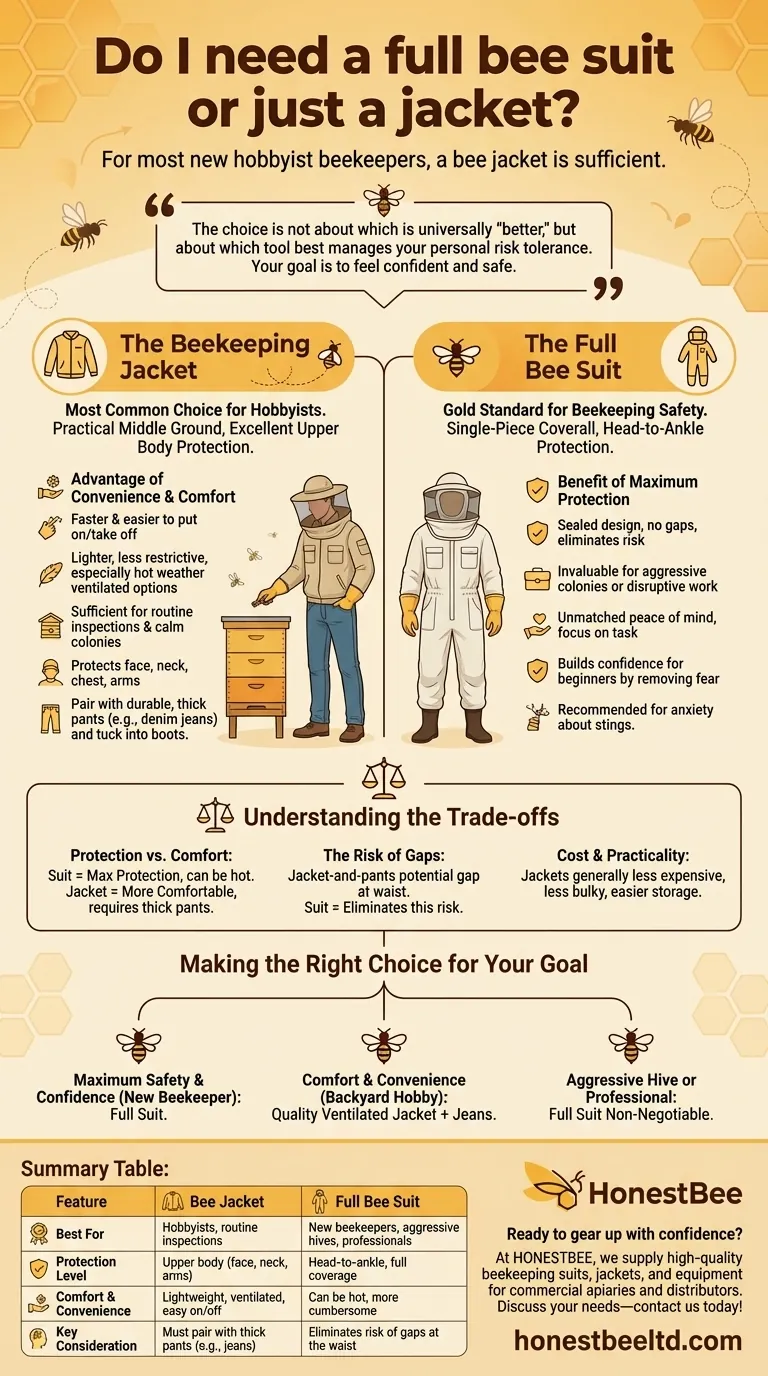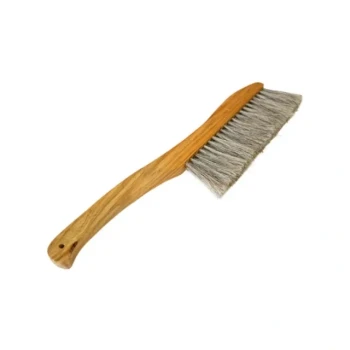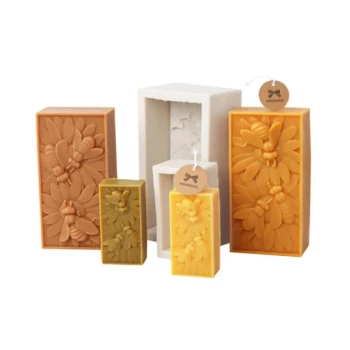For most new hobbyist beekeepers, a bee jacket is sufficient. A full bee suit offers maximum protection and is recommended if you are anxious or know your hives are aggressive, but a quality jacket paired with thick pants provides a practical balance of safety and comfort for typical hive inspections.
The choice between a full suit and a jacket is not about which is universally "better," but about which tool best manages your personal risk tolerance. Your goal is to feel confident and safe, as your calmness directly impacts the behavior of your bees.

The Case for a Beekeeping Jacket
A beekeeping jacket is the most common choice for hobbyists and for good reason. It represents a practical middle ground, offering excellent protection for the upper body, which is most often near the hive.
The Advantage of Convenience and Comfort
A jacket is significantly faster and easier to put on and take off than a full suit. This convenience means you are more likely to use it for quick tasks.
Jackets are also lighter and less restrictive, making them far more comfortable during hot weather. Many modern jackets are made from ventilated materials that offer protection while allowing for crucial airflow.
When a Jacket is Sufficient
For routine hive inspections, working with known calm colonies, or for beekeepers who feel confident around their bees, a jacket is typically all that is needed. It protects the face, neck, chest, and arms—the most common targets for stings.
What to Pair With Your Jacket
To ensure adequate protection, a bee jacket must be paired with durable, thick pants like heavy denim jeans. Tuck your pant legs into your boots to prevent bees from crawling up your legs.
The Case for a Full Bee Suit
A full bee suit is a single-piece coverall that provides head-to-ankle protection. It is the gold standard for beekeeping safety and eliminates any chance of bees finding a gap between your top and bottom layers.
The Benefit of Maximum Protection
The primary advantage of a full suit is its "sealed" design. It offers complete, uninterrupted protection, which is invaluable when dealing with an unknown or aggressive colony, or when performing disruptive hive work.
This comprehensive coverage provides unmatched peace of mind, allowing the beekeeper to focus entirely on the task at hand without worrying about a stray bee.
Building Confidence as a Beginner
For many new beekeepers, the fear of being stung is a major obstacle. Starting with a full suit can help build the confidence needed to work calmly and learn effectively. By removing the threat of stings, you can focus on mastering hive inspections.
Understanding the Trade-offs
Choosing your gear involves balancing competing priorities. There is no single right answer, only the right answer for your specific situation.
Protection vs. Comfort
This is the central trade-off. A full suit offers maximum protection but can be hot and cumbersome, especially during summer. A jacket is more comfortable but leaves your lower body more vulnerable if not paired with appropriate pants.
The Risk of Gaps
The main weakness of the jacket-and-pants combination is the potential for a gap at the waist. If your jacket rides up while you are bending over the hive, it creates an entry point for bees. A full suit completely eliminates this risk.
Cost and Practicality
Bee jackets are generally less expensive than full suits. They are also less bulky, making them easier to store and transport for beekeepers with limited space.
Making the Right Choice for Your Goal
Your decision should be based on your temperament, climate, and beekeeping goals.
- If your primary focus is maximum safety and building confidence as a new beekeeper: A full suit is the recommended starting point to eliminate any anxiety about stings.
- If your primary focus is comfort and convenience for a backyard hobby: A quality ventilated jacket paired with thick jeans is a highly effective and practical choice.
- If you are dealing with an aggressive hive or work professionally: A full suit is non-negotiable for the comprehensive protection it provides.
Ultimately, the best protective gear is the gear that makes you feel secure enough to be a calm and effective beekeeper.
Summary Table:
| Feature | Bee Jacket | Full Bee Suit |
|---|---|---|
| Best For | Hobbyists, routine inspections | New beekeepers, aggressive hives, professionals |
| Protection Level | Upper body (face, neck, arms) | Head-to-ankle, full coverage |
| Comfort & Convenience | Lightweight, ventilated, easy on/off | Can be hot, more cumbersome |
| Key Consideration | Must pair with thick pants (e.g., jeans) | Eliminates risk of gaps at the waist |
Ready to gear up with confidence? At HONESTBEE, we supply high-quality beekeeping suits, jackets, and equipment designed for commercial apiaries and distributors. Whether you're starting out or scaling up, our wholesale-focused operations ensure you get durable, reliable protection. Let's discuss your needs—contact us today to find the perfect solution for your beekeeping operation!
Visual Guide

Related Products
- Cotton Beekeeping Suit and Round Hat with Veil Bee Keeper Protective Gear
- White Beekeeping Protective Suit and Hat with Fencing Veil for Beekeepers
- Professional Beekeeping Suit for Kids and Girls Childrens Bee Keeper Suit
- Heavy Duty Cowboy Beekeeper Hat with Visibility Veil Outdoor Professional Beekeeping Protective Gear
- Beekeeper Cowboy Hat and Veil for Beekeeping
People Also Ask
- What factors should be considered when choosing a beekeeping suit? Balance Safety, Comfort & Performance
- What are bee suits made of? Choosing the Right Material for Maximum Protection & Comfort
- Why is a jacket with a hat veil recommended for beekeepers? Essential Protection for Your Face and Neck
- What should be considered regarding the color of beekeeping clothing? Ensure Your Safety and Keep Bees Calm
- What are the benefits of a fully ventilated beekeeping suit? Stay Cool and Protected in Hot Climates



















